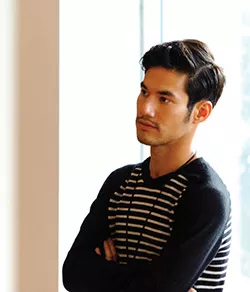Fashion Designer Joseph Altuzarra '05 on His Background, Inspiration, and Why Swarthmore

Surface: Seamless Transitions
An acute eye for detail, texture, and color place Joseph Altuzarra ['05] in a league of his own. With ready-to-wear collections inspired by everything from 18th-century dandies, to Truman Capote’s stylish “swans,” to circa 1950 American railroad workers, New York–based Altuzarra is the thinking woman’s designer. His refined pieces—in a wide range of fabrics and finishes, including linen, leather, burlap, and velvet—all tell a visual story, and often incorporate parts of the designer’s Franco-American background, as well as his love of literature, film, and dance.
Raised in Paris by a Chinese-American mother and a French father, Altuzarra studied ballet before heading to the U.S. to pursue a degree in art history at Swarthmore College. It was through these studies that his eyes were opened to the world of fashion, one that he went on to learn about from the ground up, working at maisons on both sides of the Atlantic. With early experiences at Marc Jacobs and Proenza Schouler in New York, followed by an apprenticeship with patternmaker and former Rochas head Nicolas Caito, and after a role as first assistant to Riccardo Tisci at Givenchy, Altuzarra launched his eponymous line in 2008.
You were born to a Chinese-American mother and French-Basque father. How does your background inform your design aesthetic?
It’s central to how I think about fashion and clothes and also my process. There is a duality between my French and American sides: I grew up in Paris surrounded by film and dance, so I have that French sensibility. On the other side, I’ve always been fascinated by American culture and the pragmatism, ease, and comfort it embodies. The marriage of these two sides of my personality is the Altuzarra brand.
I’ve read that you love film. Are there any movies that have been particularly impactful for you?
My parents love movies, and I grew up surrounded by all genres. One film that was particularly important was Si Versailles m’était conté [Royal Affairs in Versailles (1957)]. I watched this sprawling epic about life at Versailles over and over again, and the campy evolution of the costumes fascinated me. I also loved anything with Audrey Hepburn—Sabrina (1954) was a favorite—and tended toward less mainstream films as a teenager. Orlando (1992) had a huge effect on me because it was more ambiguous in its narrative.
Why did you choose to study at Swarthmore, and why art history?
Growing up bilingual with a Chinese-American mother, I always knew I wanted to study in the U.S. None of my classmates were going abroad for university at that time, and there were no SAT prep classes. I happened to see the film Ten Things I Hate About You (1999) in which the star ends up at Sarah Lawrence College. I looked it up online, and a box popped up saying, “If you like this school, you’ll also like Swarthmore, Amherst, Williams, Brown, and Haverford.” I applied to many of them, and one of my father’s colleagues suggested I go to Swarthmore. It was an incredible experience, as it was the first time I found my community—I was always nerdy in high school, and I finally felt free and surrounded by people like me. I loved studying art history: the analytical side of it, and the subjective way of looking at the world. I wrote an essay linking fashion advertising to classical art iconography, specifically about the influence of Toulouse-Lautrec on the Yves Saint Laurent Opium perfume advertisement with a naked Sophie Dahl. Art history spurred my love for fashion.
Read the full interview.
Born and raised in Paris, Altuzarra majored in art and art history and was a member of the track team at Swarthmore, graduating in 2005. Read his profile in The Bulletin, which appeared on the heels of his winning the 2011 Council of Fashion Designers/Vogue Fashion Fund award.



